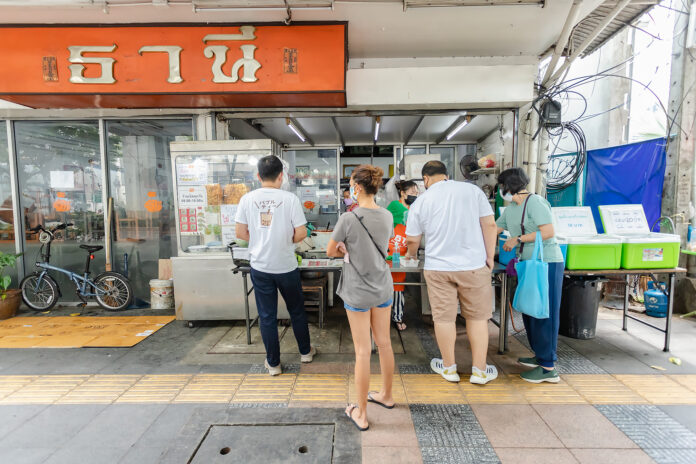Some say that Santorini, the captivating Greek island and jewel of the Aegean Sea, is the most visually arresting place on earth. Regularly topping ‘most Instagrammed location’ lists, it’s a destination focused firmly on aesthetics, from spectacular sunsets to those iconic whitewashed buildings and blue-domed houses. Yep, you know the ones…
But to enjoy Santorini purely through the eyes and the lens would be to miss out on the other sensual pleasures that the Greek island known as Thera has to offer. Nope, we’re not talking about that sensual pleasure, but rather, the incredible food of Santorini, much of which is native to the island and only grown here.
To help unearth the hidden gastronomic gems and foods found off the beaten plate, here are 10 of the best local dishes and delicacies to try in Santorini.
Tomatokeftedes
A kind of fritter using a variety of cherry tomato exclusive to Santorini, you’ll find tomatokeftedes all over Santorini as part of a meze spread, as a standalone appetiser or even as a vegetarian main.
To make tomatokeftedes, these sweet and slightly acidic tomatoes are crushed then mixed with spring onions and fresh, finely chopped herbs, usually parsley and mint. Flour is then mixed in incrementally until a batter-like consistency is achieved. Then, the fritter mix is deep fried, and is traditionally served with some strained Greek yoghurt.
While you’re here, it would be remiss not to visit Santorini’s Tomato Industrial Museum, on the island’s south coast, to learn more about this famous crop.
Roza’s taverna, in the village of Vourvoulos in the north of the island, is said to do a fine version, using tomatoes grown by Roza herself.

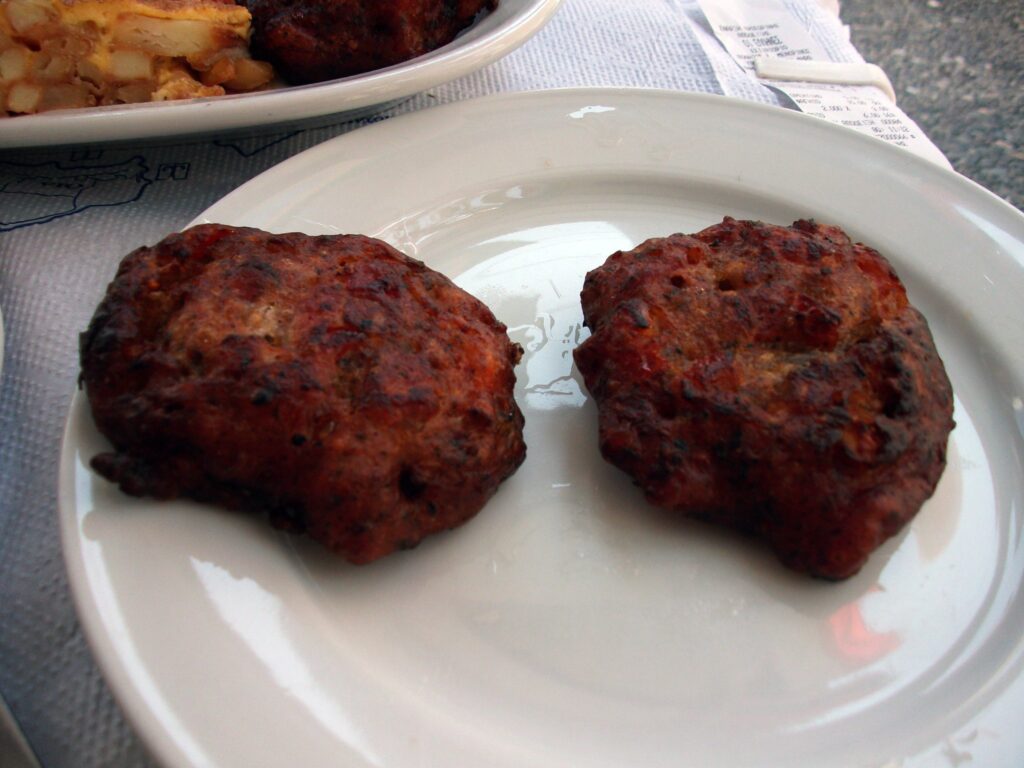
Chlorotiri
A subtly sour cheese made from sheep or goat’s milk, chlorotiri is only made by skilled local producers and this exclusivity makes it pretty hard to find on the island. If you are lucky enough to come across chlorotiri (look for oval shaped, flat slices, often sprinkled with dried thyme or oregano) you’ll savour its creamy yet refreshing quality.
Chlorotiri is often served alongside those Santorini tomatoes we mentioned earlier as part of a reviving salad, perfect for the typically hot days experienced during the island’s summer months.
If you’re in need of a cheese fix and you can’t find the elusive chlorotiri, then saganaki – a slab of haloumi or feta that’s been soaked in milk, dusted with flour and then fried – is ubiquitous on Greek taverna menus and is no less delicious.
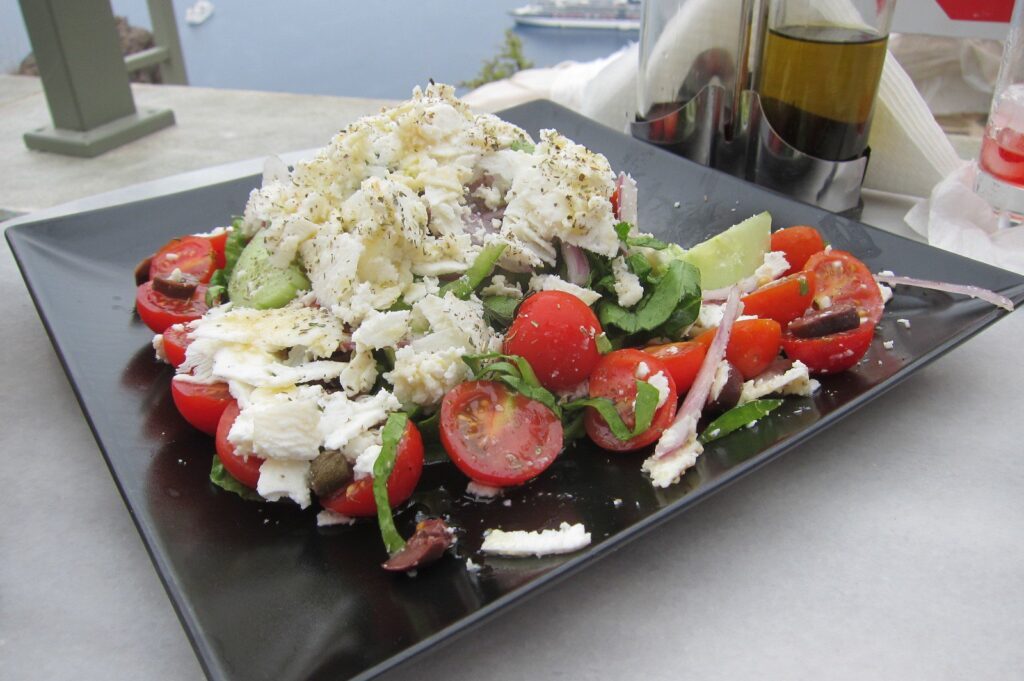
Fava
Not to be outdone by those marvellous tomatoes and piquant cheese, fava is perhaps Santorini’s most famous dish. Not actually fava beans (broad beans to those in the UK) at all, here, yellow split peas are crushed with garlic and onion before plenty of fine Greek extra virgin olive oil and lemon juice is added to create a silky, sexy, hummus-like dip.
The result is a golden-hued bowl of deliciousness (note: not green) that is often topped with finely chopped onion and a few locally grown capers, another speciality of the island, incidentally. So good is the local fava, in fact, that it’s a Protected Designation of Origin (PDO) product.
Read: 6 IDEAL foodie tips for your next trip to Greece
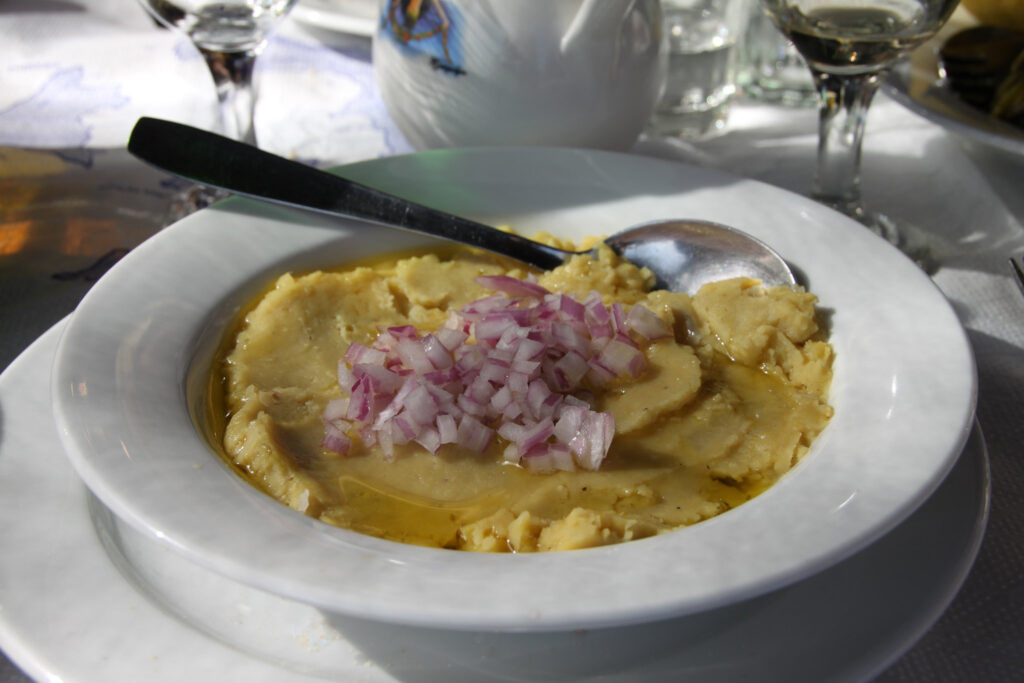
Axinos
As with any self respecting island, seafood is hugely popular in Santorini, the fresher, the better, and ideally cooked with minimal fuss and maximum respect for the ingredient.
Exemplifying this ethos is the way that Santorini’s top chefs serve locally caught sea urchin, known as axinos. Here, the barbed shell is cut open using scissors, a little extra virgin olive oil and lemon juice is drizzled over the bright orange flesh (actually the sea urchin’s ovaries), and a hunk of bread is used to scoop it all out before it’s enjoyed raw, as fresh as you like and oh-so delicious. Other times, it’s extracted from the shell and served in a bowl, but with the same dressing applied (usually, if nature’s very own bowl has been damaged).
For an expertly sourced, expertly prepared version, consider a meal at fine dining Santorini institution Selene, which regularly has axinos on the menu.

Melitzanosalata
An aubergine dip with a similar flavour profile and mouthfeel to baba ganoush, but minus the tahini, melitzanosalata makes use of another product that is local to Santorini; white aubergines. Free from that hint of bitterness that their purple cousines possess, for melitzanosalata, the white variety is grilled hard in its skins over charcoal or in the oven until the exterior is blackened and the inner flesh is yielding and smoky.
Then, the flesh is mixed with Santorini’s usual culinary suspects; local extra virgin olive oil, lemon juice and seasoning. To finish, finely chopped parsley and fresh whole olives top the melitzanosalata. Enjoy!
In Pyros, locals rave about the quality of the melitzanosalata at Kantouni Restaurant. Their fava is excellent, too.
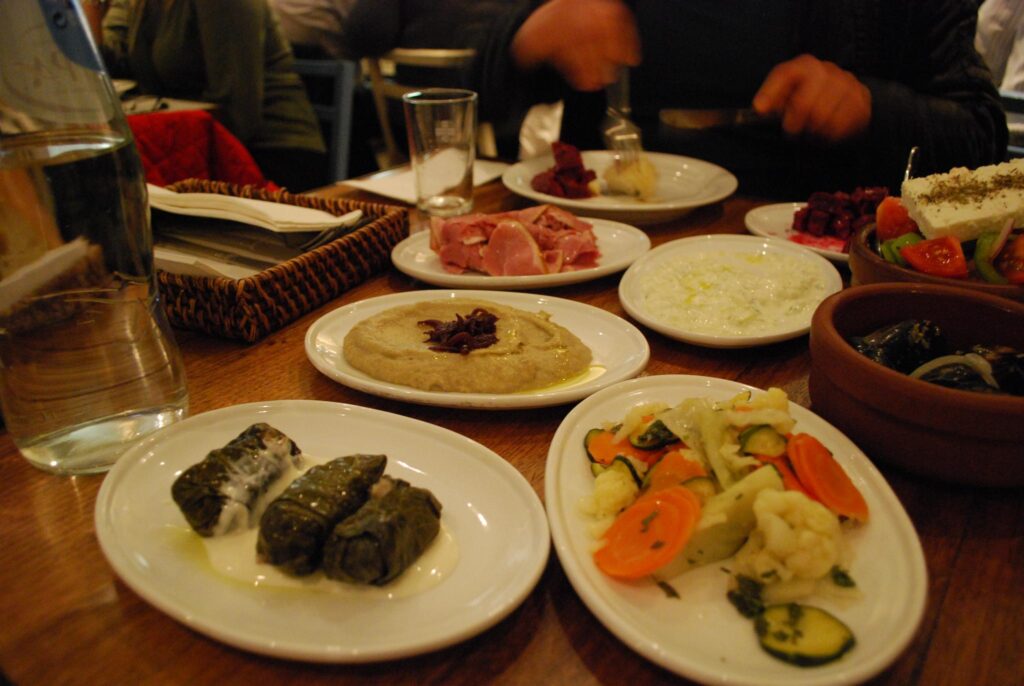
Kopania
These traditional Santorinian sweet treats showcase the resourcefulness of island cuisine, making delicious confections from simple ingredients. Kopania are small, round sweets made primarily from barley rusks that have been ground into a fine powder, then mixed with raisins that have been soaked in local Vinsanto wine.
The mixture is enriched with crushed almonds, cinnamon, and cloves before being shaped into small balls and generously coated with sesame seeds. The result is a nutritious, not-too-sweet delicacy with a complex flavour profile that perfectly balances nuttiness, spice, and subtle wine notes. Traditionally served alongside Greek coffee or as a quick energy boost for farmers working the volcanic fields, kopania represents Santorini’s ability to create something special from the limited resources available on the island.
Kapari Toursi
Capers grow wild across Santorini’s volcanic landscape, thriving in the dry, mineral-rich soil. What makes the island’s capers special is their intensely aromatic flavor—more pronounced than capers from other regions. Kapari toursi is the traditional preservation method that transforms these foraged flower buds into a year-round delicacy.
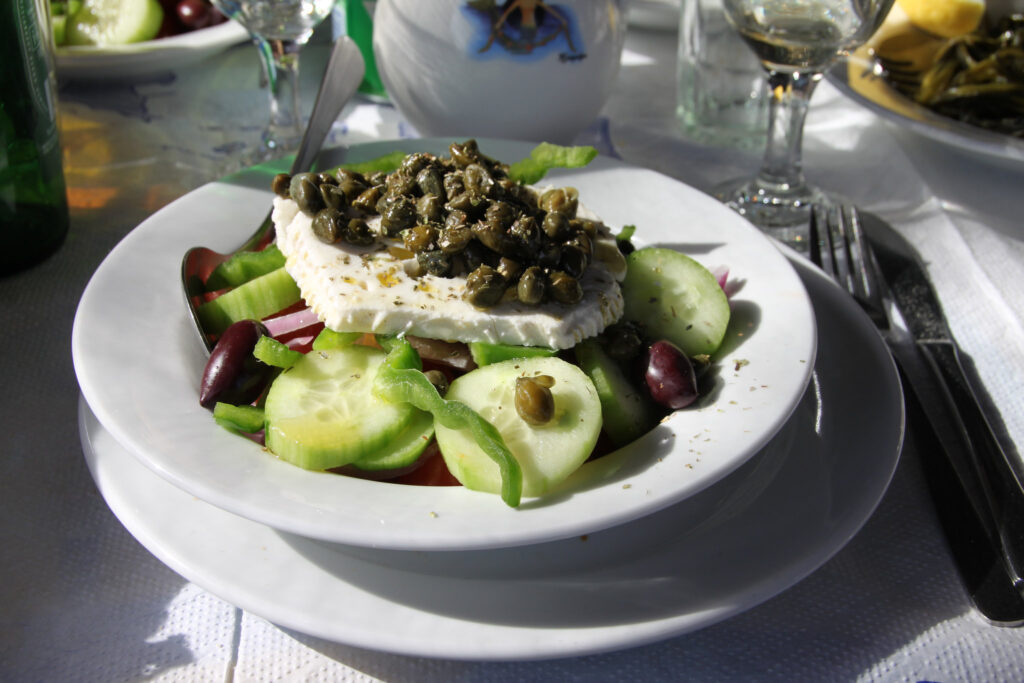
The unopened buds are carefully handpicked, then preserved in a solution of sea salt and Santorinian vinegar. After fermenting for several weeks, the capers develop their distinctive tangy, briny finish. Served as part of a meze spread or used to elevate various dishes like a Greek salad with goats cheese, these pickled capers add a characteristic burst of flavour that encapsulates Santorini’s terroir. You’ll find them garnishing numerous dishes across the island, from salads to fish preparations, adding both visual appeal and a punch of authentic local flavour.
Read: Are there any genuine hidden gems left in Greece?
Brantada
This traditional Cycladic fish dish holds a special place in Santorini’s coastal cuisine. Brantada features salt cod that has been soaked, then coated in a rich garlic sauce emulsion before being lightly fried to perfection. The sauce, made from an abundance of garlic, vinegar, and the island’s fruity olive oil, creates a distinctive, sauve flavour that’s both bold and refined.
The preparation method is believed to have originated as a preservation technique among fishing communities across the Cyclades, including Santorini. Today, it’s considered something of a delicacy, often served with skordalia (garlic mashed potatoes) and a generous drizzle of olive oil. The contrast between the crisp exterior and tender, flaky fish within makes brantada a must-try for seafood enthusiasts visiting the island.
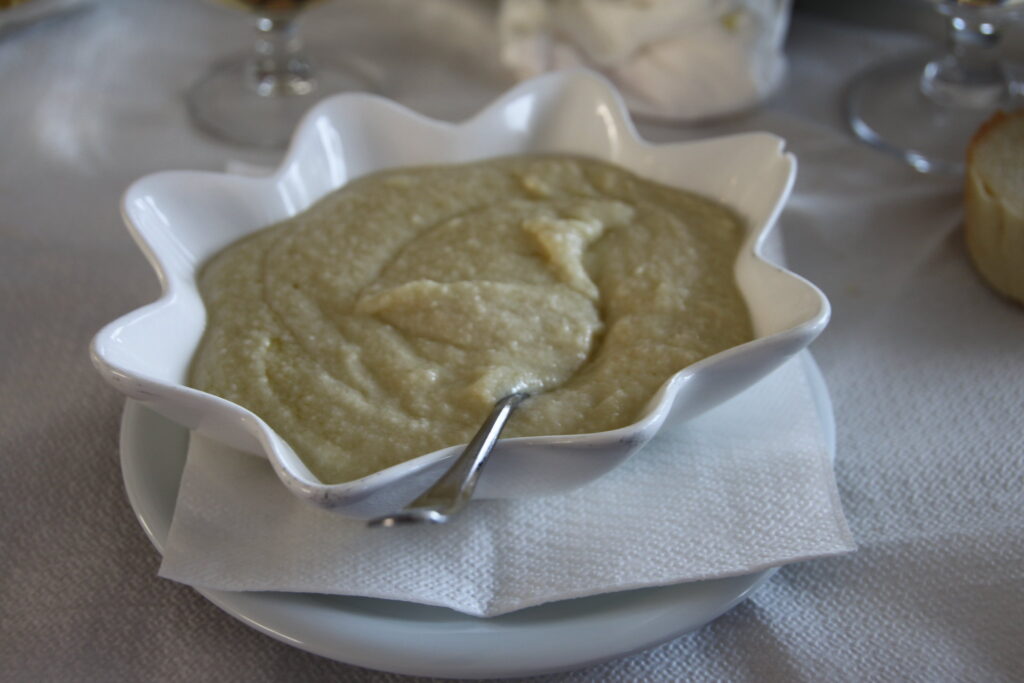
Grilled Octopus
Whilst grilled octopus is famous across all the Greek islands, we simply couldn’t leave it out of a comprehensive guide to Santorini’s gastronomic treasures.
Here on the island, local tavernas and seaside restaurants serve this Aegean classic with love. Santorini’s xtapodi is traditionally prepared by first tenderising the octopus (often by beating it against coastal rocks – a sight you might witness if you’re up early enough to catch the local fishermen at work). After this rather dramatic introduction to island life, the octopus is hung to dry in the Mediterranean sun before being chargrilled over open flames.
The result is nothing short of magnificent – smoky, caramelised tentacles with a perfect balance of chewiness and tenderness, simply dressed with the island’s prized olive oil, fresh lemon juice, and a scattering of dried oregano. Accompanied by a glass of crisp Assyrtiko wine (more on that in a moment), this is the quintessential Santorini sunset experience.
For an exceptional octopus dish with unparalleled views, head to Ammoudi Fish Tavern in Oia’s port, where the day’s catch is displayed prominently before being expertly prepared mere metres from the Aegean waters.
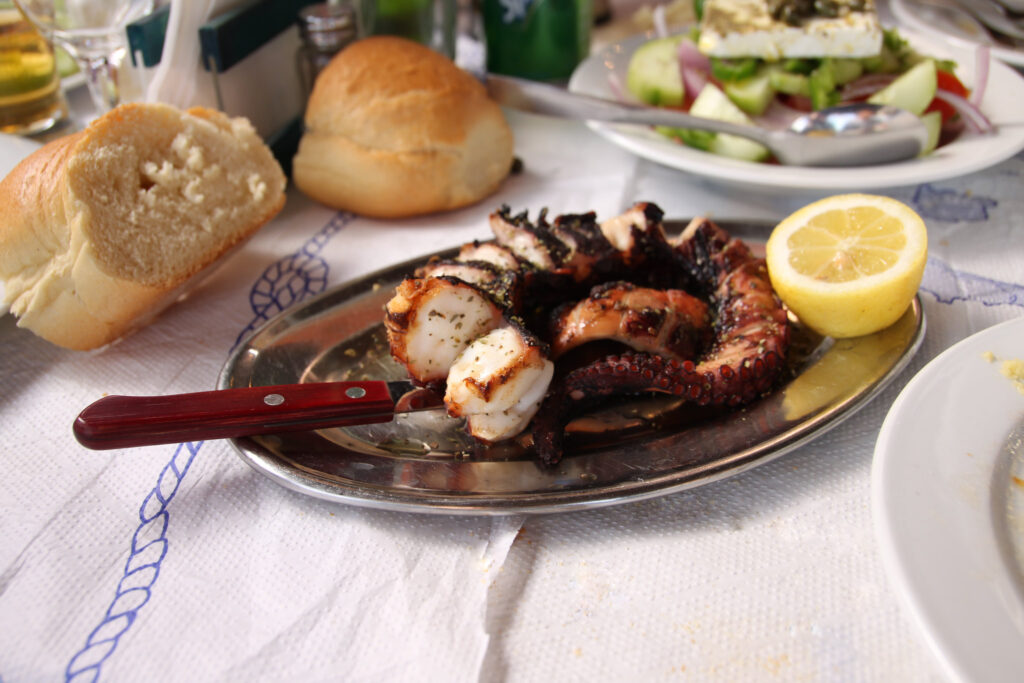
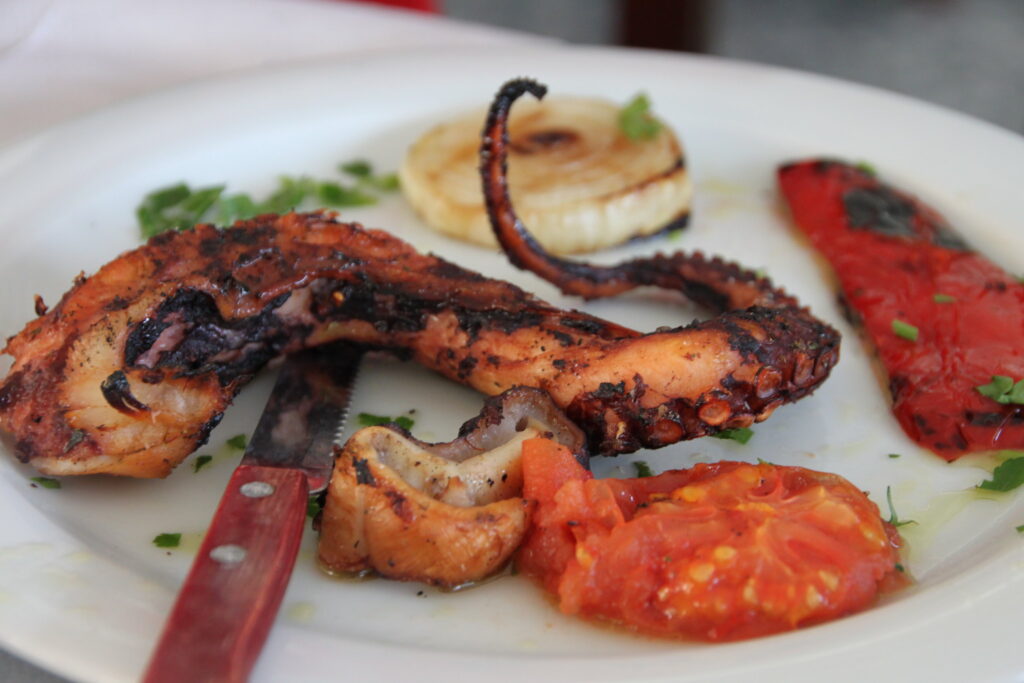

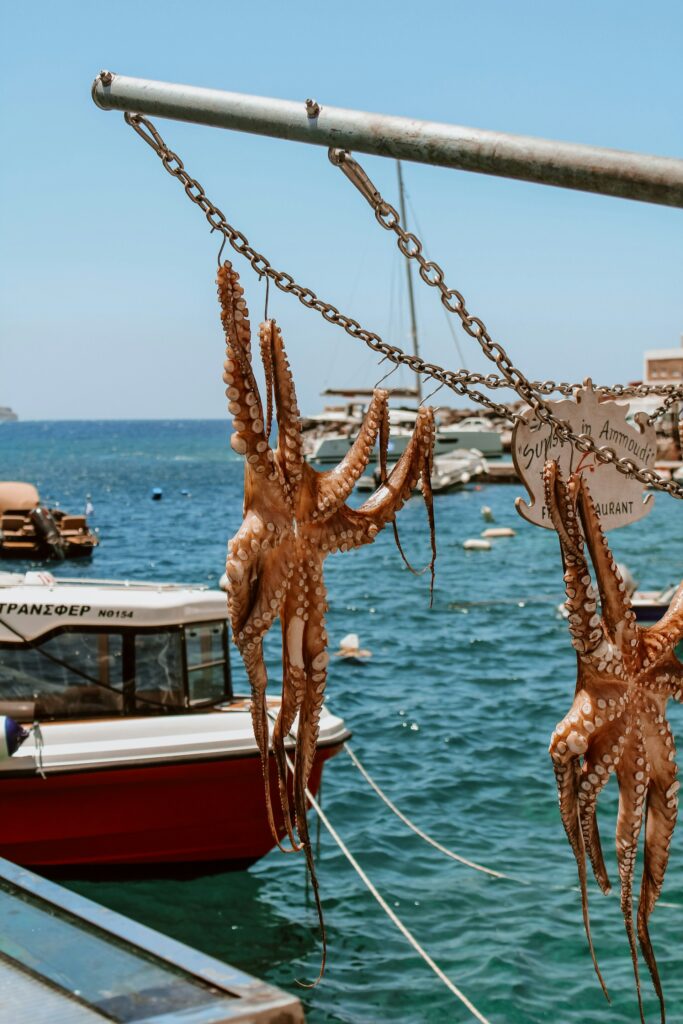
Local Santorinian Wine
Santorini is sometimes referred to as the Wine Island, and it’s easy to see why. Due to the island’s dry and volcanic landscape and mineral-rich soil, there are indigenous grape varieties only found on these shores. This, of course, lends itself to some rare local wines.
If this is going to be your first time visiting Santorini, we’d recommend first sampling the famous Assyrtiko dry white wine of the region, which contains distinctive volcanic mineral notes and the intoxicating aroma of citrus fruit. From this entry level, expand whichever way your taste buds take you, though you shouldn’t miss the island’s famous, naturally sweet dessert wine, Visanto, which is just perfect when paired with a freshly baked baklava.
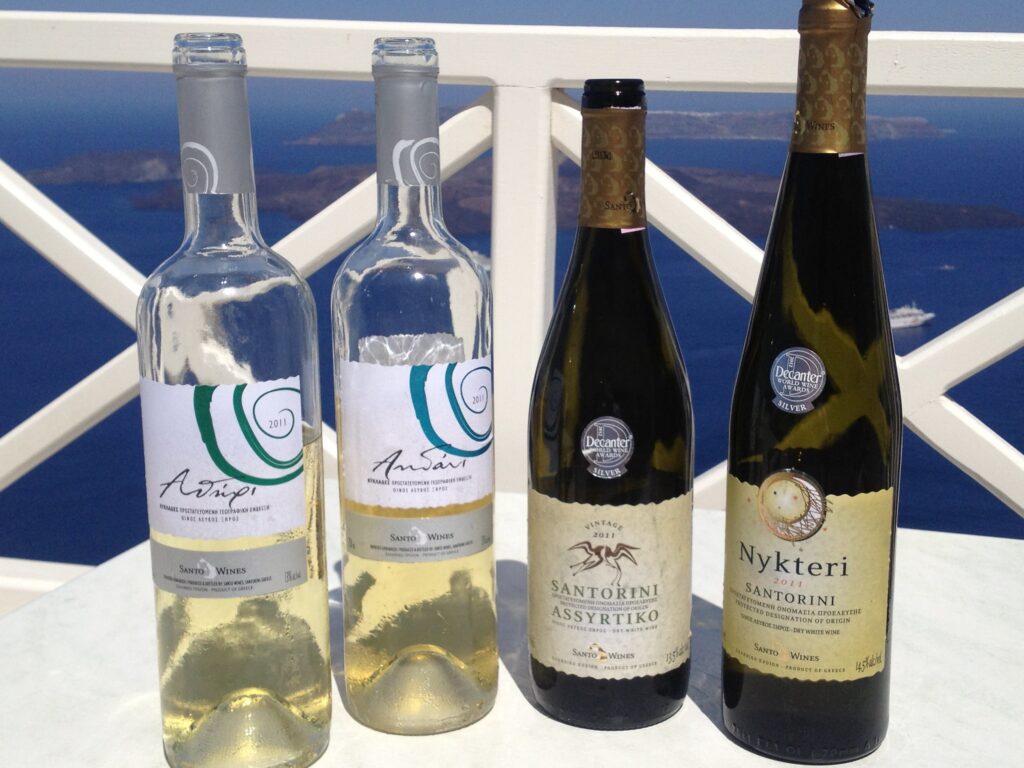
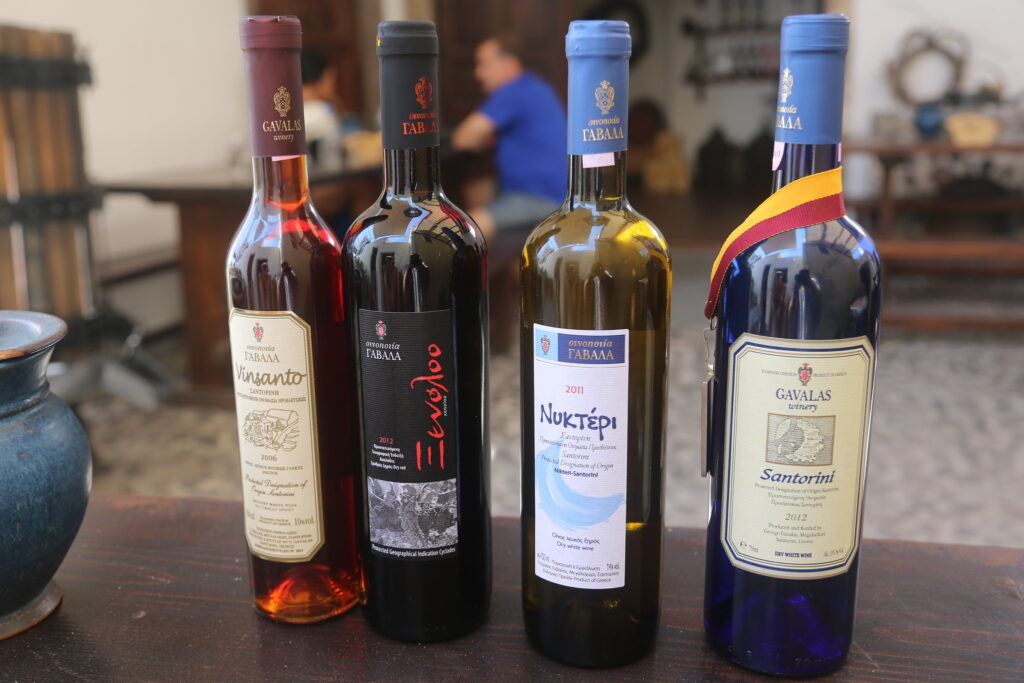
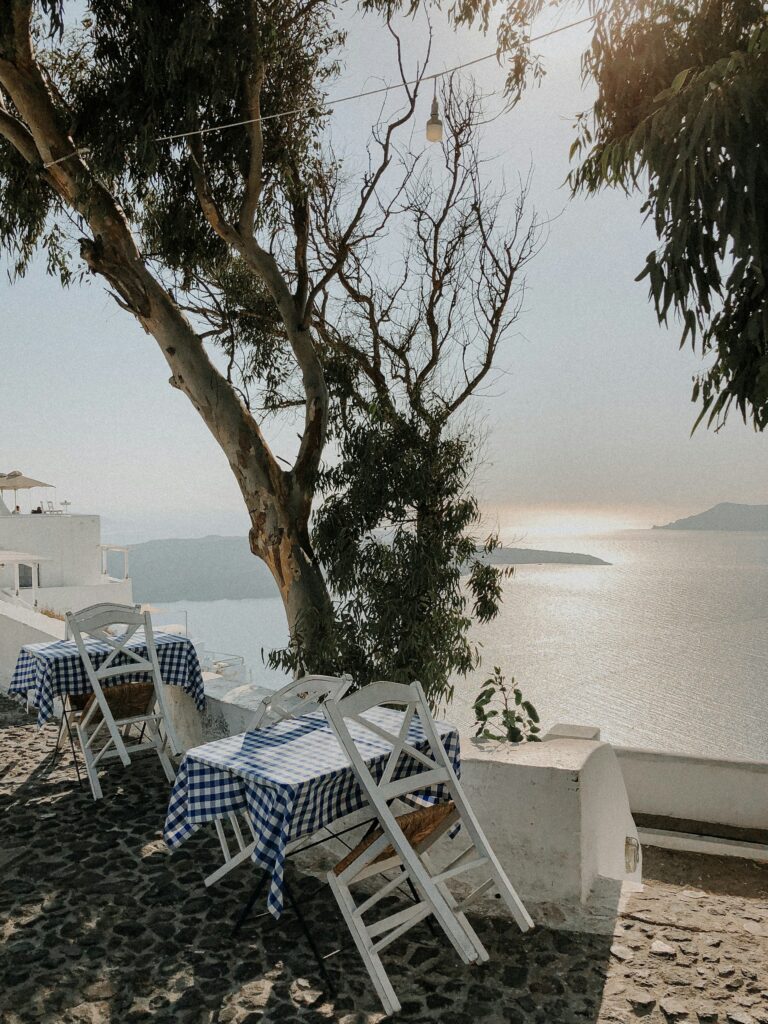
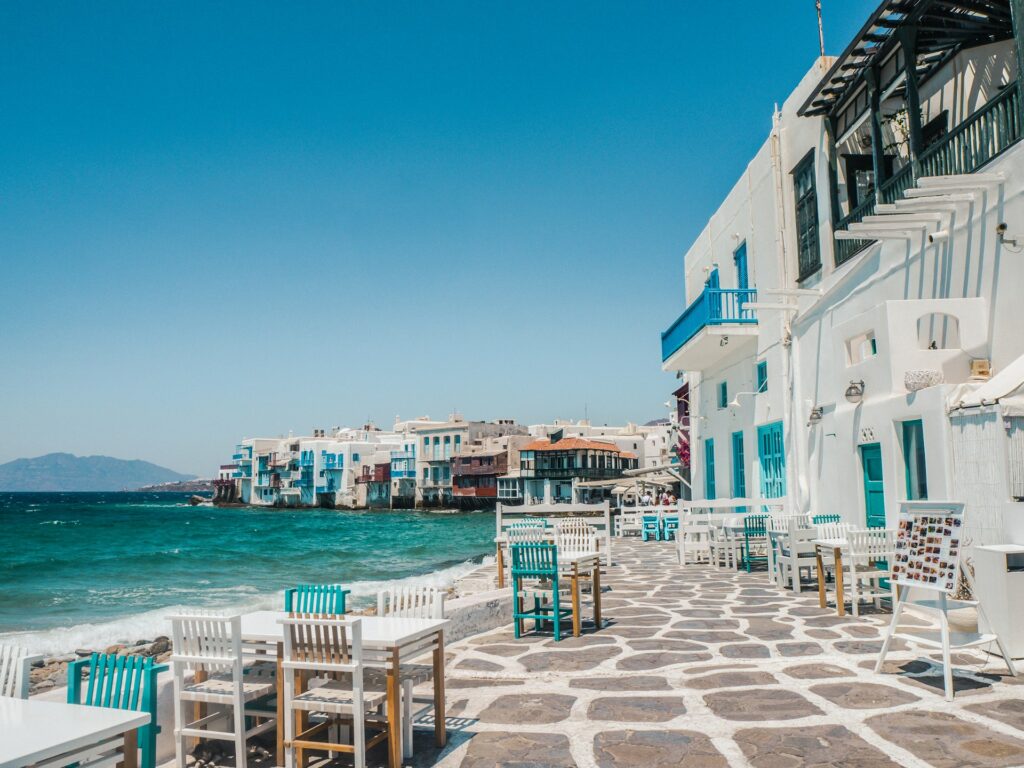
To truly appreciate the island’s unique viticulture, explore luxury Santorini tours that offer intimate experiences at the island’s premier wineries. The best tours combine wine tasting with breathtaking caldera sunset views, taking you to prestigious estates like Argyros, where you can sample world-class Assyrtiko in an elegant setting surrounded by vineyards.
Continue to family-owned cellars like Gavalas Winery in Megalochori village for a taste of tradition, before concluding at the architecturally stunning Venetsanos Winery, perfectly positioned for dramatic sunset views over the volcanic landscape while enjoying exceptional local vintages.
Hungry for more Greek eats, sweet treats, and, erm, drinks neat? Then join us in Mykonos next. You might want to pack an extra stomach…




